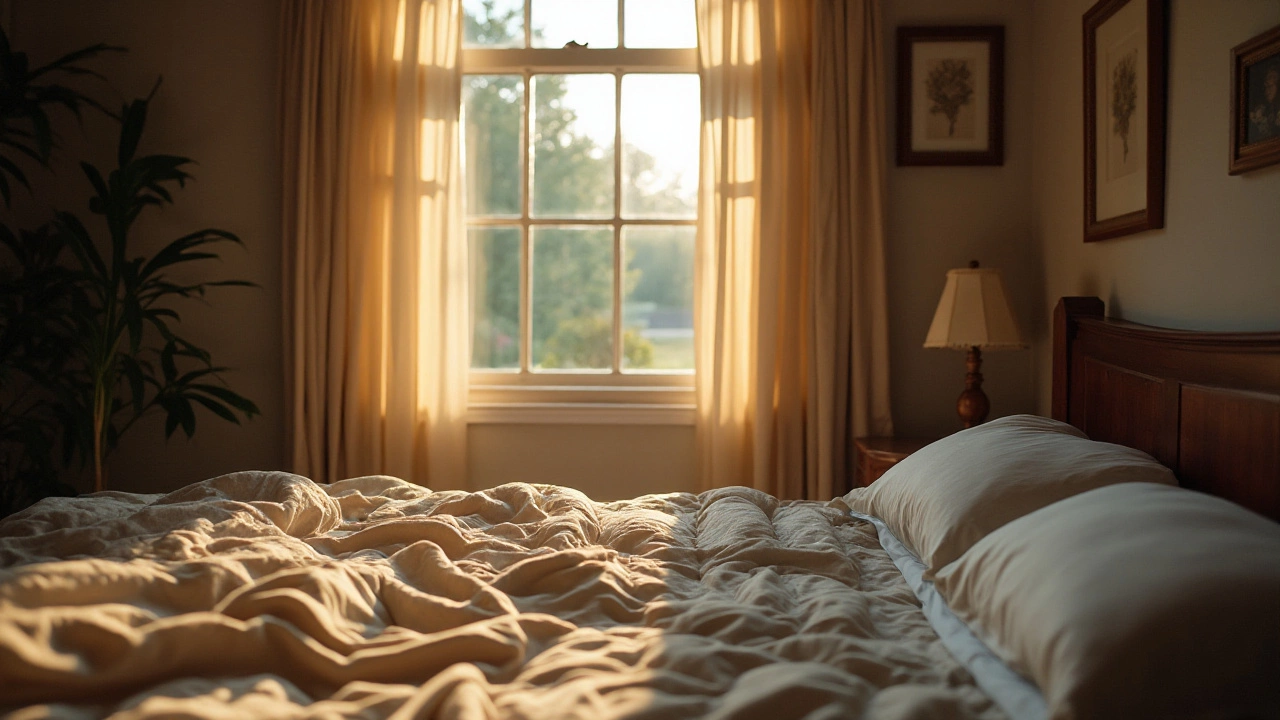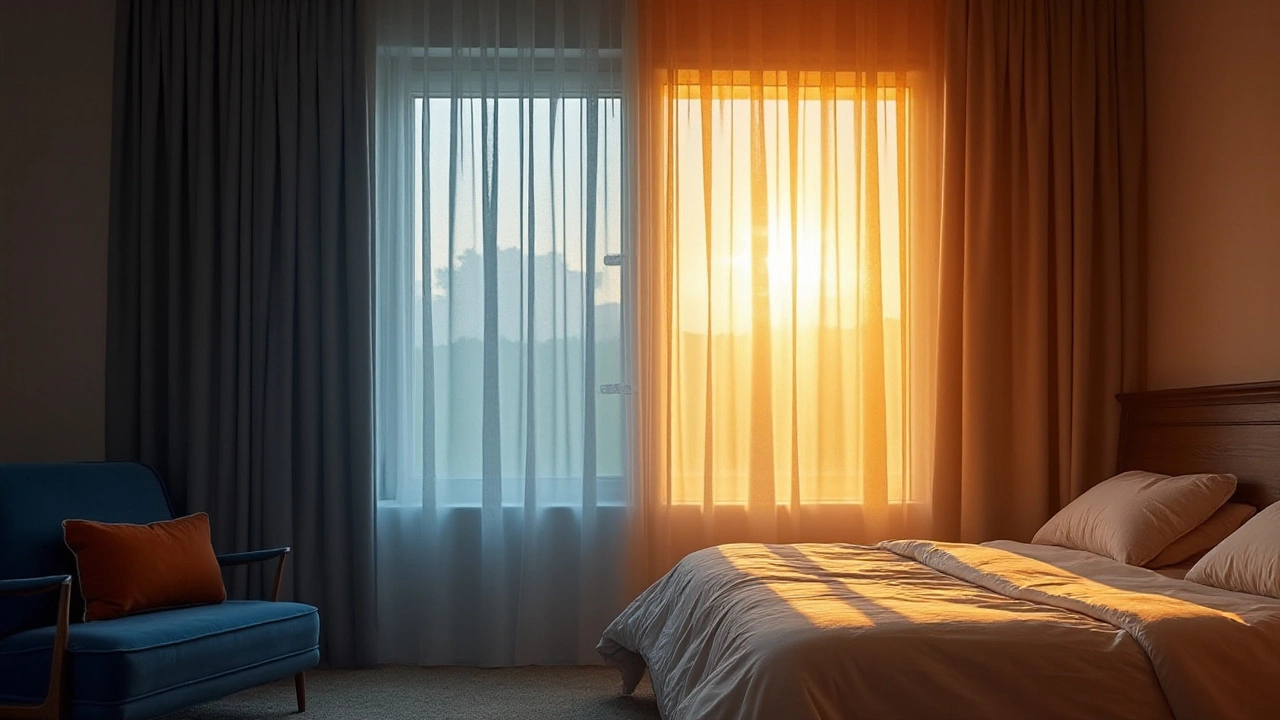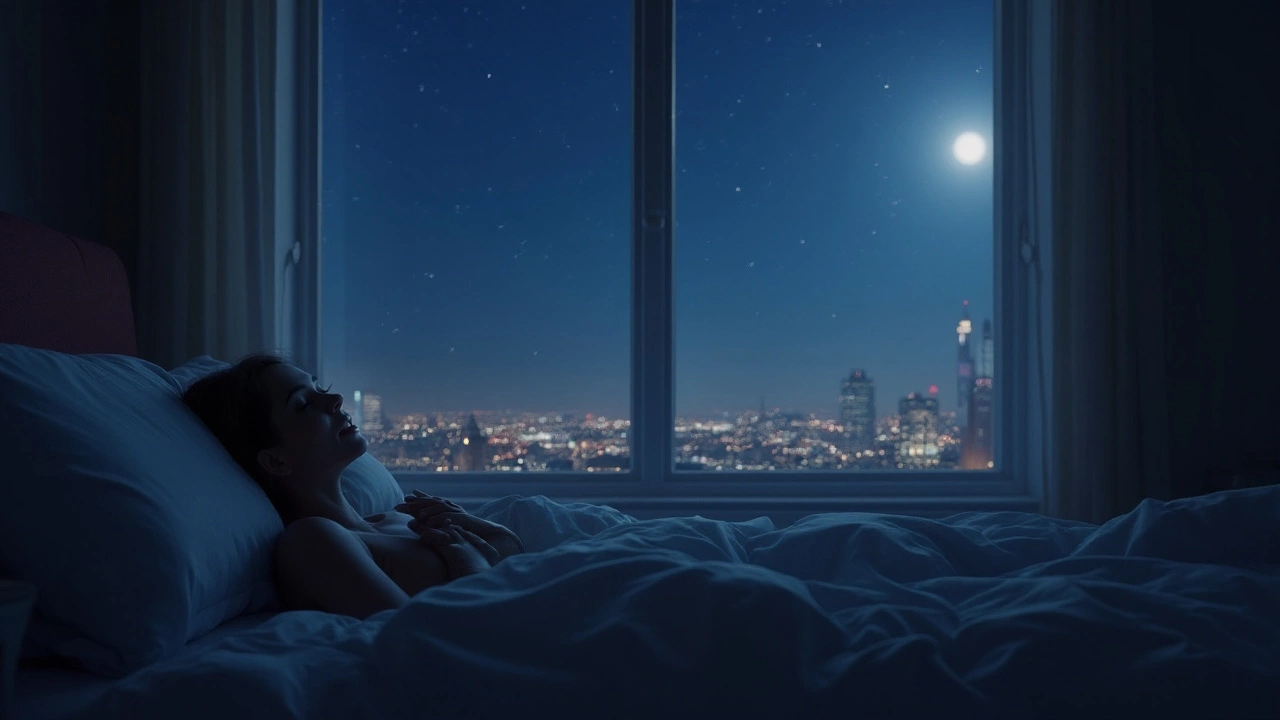Is Sleeping Without Curtains a Good Idea for Better Rest?
 Jan, 4 2025
Jan, 4 2025
Imagine waking up to the gentle glow of dawn, sunlight streaming in to serenade you into a new day. For some, this sounds like an ideal start, whereas for others, it might induce a morning grumble. The absence of curtains in the bedroom introduces the intriguing question of whether it truly enhances or hinders the sleep experience.
There is something oddly liberating yet risky about allowing natural light and the outside world to enter your most personal space unfiltered. Questions of privacy, sleep quality, and personal comfort all emerge. Some swear by the invigorating powers of a sunlit room, while others are deeply attached to their drawn curtains, cherishing the sense of security and exact darkness they offer.
As we embark on this exploration, consider what really constitutes a good night's sleep and how much influence the presence or absence of curtains in your bedroom might hold over it. Is it a brave new world to embrace or an unnecessary gamble with your rest?
- The Impact of Natural Light on Sleep
- Privacy Concerns Without Curtains
- Psychological Effects of Unobscured Views
- Practical Tips for Living Curtain-Free
- Balancing Benefits and Drawbacks
The Impact of Natural Light on Sleep
The relationship between sleep and exposure to natural light is a nuanced one, intertwined with our body's circadian rhythms and overall well-being. It's essential to recognize that our ancestors lived in harmony with the sun—they awoke with its rise and rested when it set. Today, with the advent of artificial lighting and endless screens, this connection has waned, impacting our natural sleep cycles. Numerous studies suggest that natural light exposure, particularly in the morning, plays a pivotal role in regulating our internal body clock. By optimizing our exposure to natural light, especially upon waking, we can potentially improve both the quality and duration of our sleep, leaving us more refreshed and vigilant during the day.
One of the primary reasons natural light influences our sleep so significantly is due to its effect on melatonin production. Melatonin, often dubbed the ‘sleep hormone,’ is sensitive to light—its production increases in darkness, signaling our body it's time to rest. The introduction of natural light in the morning halts melatonin production, aiding a smooth transition into wakefulness. This natural alarm clock can be particularly beneficial, setting a consistent routine that helps maintain a harmonious sleep cycle. But it’s not just about the morning; increased daylight exposure is linked to enhanced sleep quality at night. This is especially relevant in today's world, needing balance and routine in often chaotic lifestyles.
However, the advantages of letting natural light fill your space aren't universal. Some individuals find the early morning light intrusive, especially those whose work or lifestyle demands odd sleeping hours. For them, maintaining a dark environment may prove more conducive to achieving deep sleep stages. On the contrary, those who struggle to wake up or feel groggy in the early hours might find that exposure to sunlight acts as a gentle invigorator, helping set a positive tone for the day. This is supported by a publication in the Journal of Clinical Sleep Medicine,
"A night of quality rest followed by a dose of morning sunshine sets a beneficial lifecycle for heightened alertness during daytime activities."Different lifestyles and personal preferences make the blanket removal of curtains a decision worthy of consideration.
As we delve deeper into the science of light and sleep, it’s worth highlighting the data that supports such considerations. A recent study indicated that workers who sat by windows received 173 percent more natural white light exposure during work hours, slept an average of 46 minutes more per night, and experienced better quality sleep than those without windows. These insights emphasize the profound impact that simple exposure to natural light can have on sleep, impacting even those seemingly small decisions like ignoring curtains. Therefore, while the choice of whether or not to sleep curtain-free can depend on various factors, the potential sleep enhancements and overall health benefits of natural light are substantial enough to merit genuine consideration.
Privacy Concerns Without Curtains
The decision to sleep without curtains often boils down to a trade-off between natural aesthetics and personal privacy. One of the main worries when opting for bare windows is how much of your life is potentially on display to the outside world. This becomes particularly pertinent in urban environments where homes are in close proximity, or in ground-floor bedrooms where passersby might catch a glimpse inside.
The idea of living without curtains can evoke a sense of vulnerability, especially at night when the interior lights are on, turning your room into a vivid showcase for anyone who happens to look in. According to a study by the Environmental Psychology Department at a well-regarded university, people generally express discomfort with the notion of being visible within their own homes, highlighting the innate human desire for control over what others see.
"Curtains offer not just physical coverage but a psychological shield," states Dr. Elaine Matthews, a renowned environmental psychologist. "They are a kind of mental barrier that provides individuals a sense of safety from the outside gaze."
Residents who have chosen to forego curtains often cite the calming influence of unobstructed views, allowing them to connect with their surroundings. However, this comes with the imperative need to balance openness with securing private life. In neighborhoods where homes face each other, many have turned to shading solutions like frosted window films or strategically planted foliage to mask visibility without sacrificing natural daylight.
For those considering this lifestyle, understanding the context in which you live can be pivotal. Living in remote areas might allow for more privacy than densely populated cities, easing concerns over potential prying eyes.
| Urban Living | Rural Living |
|---|---|
| Requires strategic planning for privacy. | Usually more secluded, offering natural privacy. |
Thus, when contemplating the daring move of living without curtains, it’s essential to weigh these privacy concerns against the charm and benefits of letting natural light flow freely inside your home. Ultimately, the decision reflects personal comfort levels and environmental factors that vary greatly from one setting to another.

Psychological Effects of Unobscured Views
Embracing a bedroom environment without curtains can provide an exhilarating sense of openness, but it's not without its psychological ramifications. On one hand, having unobstructed views could evoke a feeling of harmony with the outside world, fostering a connection to nature and surroundings. This element of exposure might boost one’s mood and adaptability by emphasizing transparency and vulnerability, allowing natural light to synchronize one's internal clock with the day’s cycles. There’s something undeniably grounding about gazing out at an expansive sky or lush greenery that fills the mind with tranquility and inspiration.
However, not everyone finds comfort in such openness. For some, the lack of barriers might induce feelings of being exposed or watched, especially in urban areas where privacy is often limited. The concept of privacy is vital in personal spaces, and removing curtains can blur the lines between solitude and public exposure. The constant presence of an open view may lead to anxiety for those who crave a sense of security that only a closed-off space can provide. As Terry Pratchett once said,
“The trouble with having an open mind, of course, is that people will insist on coming along and trying to put things in it.”This sentiment can apply to having open windows as well, as the uninterrupted exterior world may imprint unexpected stressors on an unwitting mind.
Moreover, the psychological effects of open views without curtains extend to how one's mood and productivity can be influenced by changing lighting conditions. Studies have shown that individuals exposed to natural light during the day tend to enjoy elevated levels of productivity, alertness, and overall well-being. Yet, the lack of control over how much light one is exposed to could disrupt this balance, especially during early sunrise hours or high-noon glare, becoming a double-edged sword for different lifestyle patterns.
Examining the value of personal space, it is essential to recognize that while sleeping without curtains may mean embracing life's unpredictability, it could also disrupt established routines and psychological consistency. It is the very essence of the human condition to both crave spontaneity and resist the potential chaos that can come from it. An interesting paradox emerges when we weigh the freedom of transparent living against the responsibility to protect one's mental sanctity. Thus, finding one's sweet spot between openness and privacy becomes a deeply personal decision that must consider individual temperaments, preferences, and daily habits.
Practical Tips for Living Curtain-Free
Embracing a life sans curtains may initially seem daunting, but with the right approach, it can truly transform your living space and the quality of your sleep without curtains. The key lies in striking a balance between welcoming natural light and maintaining your privacy. Begin by evaluating your surroundings: examine the positioning of your windows, the direction they face, and the views they offer. If you have large windows that invite excessive sunlight, you may want to consider window films or strategically placed indoor plants to dim the light while still allowing its charm to filter in.
Privacy is a common concern for those ready to toss their curtains, but there are creative solutions. Frosted glass or decorative glass films can provide both protection and beauty, blurring the line between captive and captive-free. If you're fortunate to enjoy a secluded area with little human traffic peering in, feel free to relish in the openness. Nonetheless, for the urban dwellers among us, utilizing smart glass technology, which turns transparent windows opaque with a click, can be an impressive, albeit pricey, alternative.
Let’s not forget the importance of insulation, especially if you reside in regions with fluctuating temperatures. Curtains often serve as a barrier between the indoors and the weather, but their absence doesn’t mean sacrificing comfort. Investing in high-quality window insulation strips can prevent drafts, while the strategic use of heavy fabrics, like woolen or quilted blankets during winter months when temperatures dip, keeps rooms cozy without sacrificing the joy of natural light.
If morning light is proving too vigorous for your liking, consider wearing an eye mask to experience the bliss of darkness without the drapes. Eye masks preserve your body’s natural ability to regulate circadian rhythms, which are tied to natural light exposure during the day and darkness at night. Don’t underestimate the power of well-placed reflective surfaces, as they bounce light around the space, reducing the need for artificial lighting during twilight hours.
"Light exposure in the morning energizes you by resetting your biological clock," says Dr. David Watson, a well-known sleep researcher. "Yet, it’s about aligning these exposures with desired outcomes, hence why some might choose to mediate it in unique ways, such as curtain-free living."
Finally, a harmonious design approach can help integrate a curtain-free life seamlessly into your decor. Choose window frames that serve as focal points rather than forgetting neutral shades that complement existing aesthetics. By placing vibrant art pieces or visually pleasing accessories around window areas, you add a personalized touch that doesn't solely rely on windows for allure. Curtain-free or not, making windows part of your décor story will enrich the essence of your space.

Balancing Benefits and Drawbacks
Deciding whether to sleep without curtains involves weighing natural light against one's need for privacy and comfort. On one hand, exposure to early morning light can positively impact the body's internal clock. Studies have shown that sunlight can enhance vitamin D production and regulate our circadian rhythms, contributing to a deeper and more restorative sleep pattern. The gentle awakening prompted by nature’s glow might reduce reliance on loud alarm clocks, making mornings much less jarring.
However, with the gain of natural light comes the potential loss of privacy, which remains a crucial concern. Without curtains to obscure the window, you expose your abode to the outside world, sometimes resulting in discomfort. For those living in bustling urban environments, streetlights and passing cars might disrupt tranquility, requiring a strategic approach to manage these interruptions. Indeed, windows without curtains can affect how secure and private individuals feel in their own homes.
Consequently, finding a balance between the benefits of natural exposure and maintaining privacy becomes absolutely essential. Some opt for a halfway solution, using sheer curtains that blur intrusive views while still allowing ample sunshine to pass through. Others turn to technology, with smart blinds that synchronize with sunrise and sunset, offering the flexibility to enjoy nighttime solitude and daytime openness without the constant need for manual adjustments.
Embracing the outside world entails a nuanced consideration of both emotional and logistical aspects. Do the pros of enhanced sleep quality and reduced sleep inertia outweigh the potential downsides of decreased privacy? Personal preferences, lifestyle, and surroundings all influence the final decision. For some, this might mean a complete farewell to curtains, for others, a delicate mix of traditions and innovations. Ultimately, the choice rests on aligning one's daily rhythm with comfort and privacy needs.